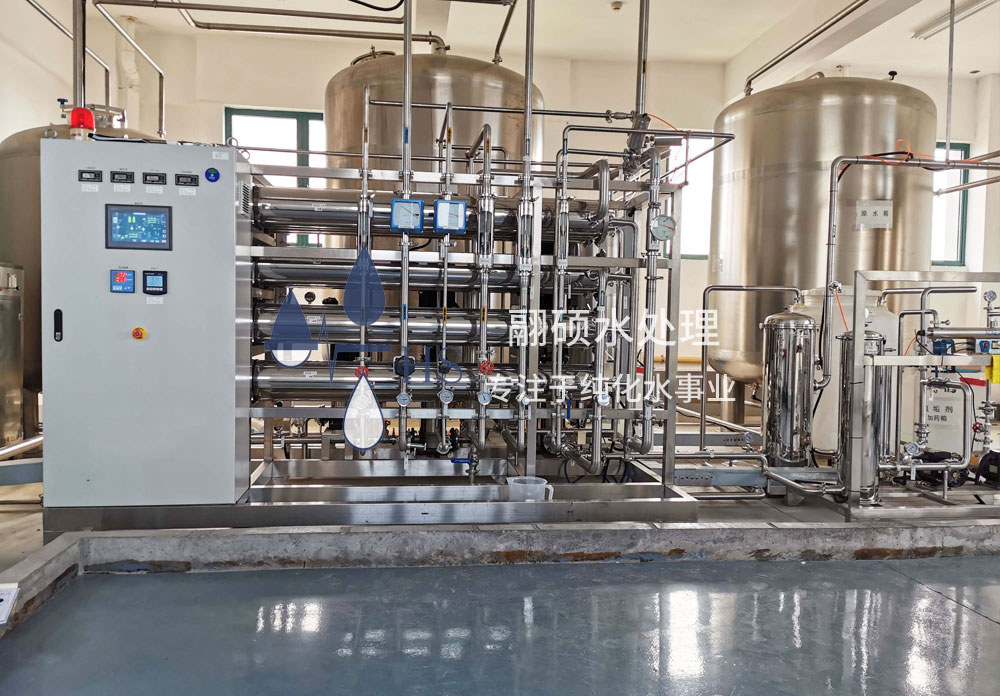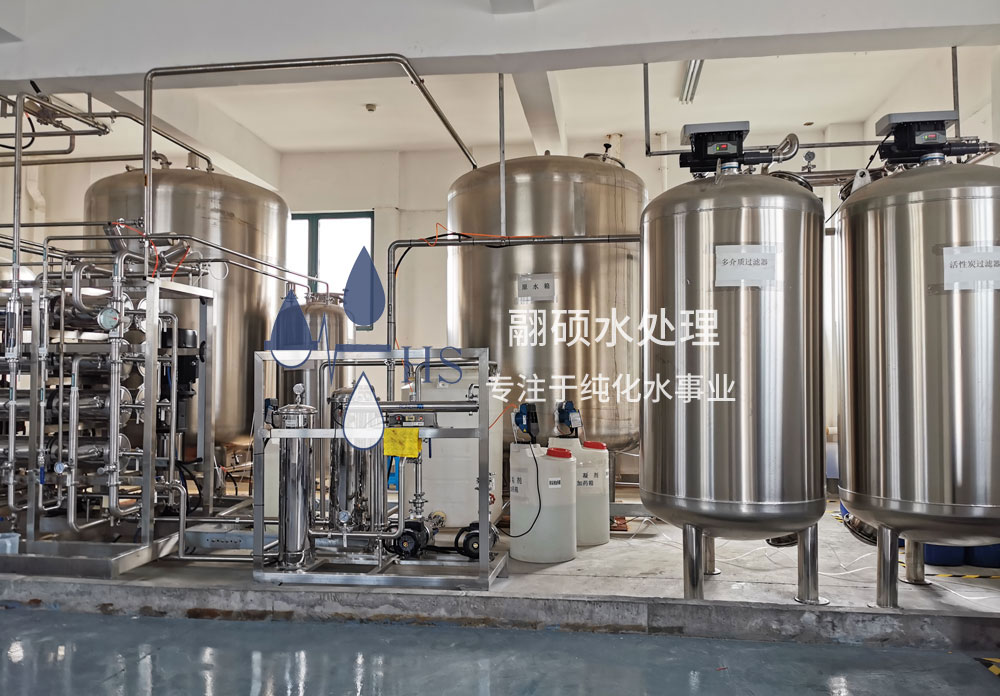الأجهزة الطبية تنقية المياه
فائدة نموذج يتعلق تنقية المياه معدات تنظيف الأجهزة الطبية ، التي هي عالية الكفاءة ، والموثوقية ، والسلامة ، وتوفير الطاقة وحماية البيئة الطبية معدات معالجة المياه . معظم شركات الأدوية في الداخل وال...
Product details
فائدة نموذج يتعلق تنقية المياه معدات تنظيف الأجهزة الطبية ، التي هي عالية الكفاءة ، والموثوقية ، والسلامة ، وتوفير الطاقة وحماية البيئة الطبية معدات معالجة المياه . معظم شركات الأدوية في الداخل والخارج استخدام المعالجة + التناضح العكسي ، التبادل اﻻلكتروني للبيانات وغيرها من طرق تصنيع المياه النقية ، من خلال تقطير المياه للحقن . غشاء التناضح العكسي يمكن إزالة الكائنات الحية الدقيقة ، پايروجن والفيروسات والمواد العضوية في الماء بنسبة 100 ٪ . على الرغم من أن الثانوية التناضح العكسي يمكن تجنب استخدام راتنجات التبادل الأيوني ، ولكن محتوى الملح من المياه الخام عالية جدا . المياه النقية المستخدمة في الطب يتطلب أكثر صرامة وأعلى جودة المياه ، مقاومة فائقة نقية الطاقة الكهرمائية غالبا ما يتطلب أكثر من 15 تريليون دولار . وفقا لخصائص المياه النقية جدا المستخدمة في صناعة المستحضرات الصيدلانية ، لدينا مصنع تصميم مجموعة كاملة من عملية معالجة المياه النقية من التناضح العكسي ، التبادل اﻻلكتروني للبيانات وغيرها من التكنولوجيات الجديدة ، من أجل تلبية متطلبات المياه النقية من مصانع الأدوية والمستشفيات التسريب .
معايير جودة المياه النقية من معدات تنقية المياه الصيدلانية البيولوجية ( معدات معالجة المياه الطبية ) تستند أساسا على دستور عام 2020 و برنامج الرصد العالمي ، بما في ذلك المقاومة الكهربائية ، والموصلية الكهربائية ، الأمونيا ، الملح والمعادن الثقيلة . المقاومة يجب أن تكون أكبر من أو يساوي 0.5m Ω . CM, الموصلية الكهربائية يجب أن تكون أقل من أو يساوي 2 ميكروغرام / مل ، محتوى الأمونيا يجب أن تكون أقل من أو يساوي 0.3 ميكروغرام / مل ، محتوى الملح يجب أن تكون أقل من أو يساوي 0.06 ميكروغرام / مل ، محتوى المعادن الثقيلة يجب أن تكون أقل من أو يساوي 0.5 ميكروغرام / مل .
عملية تنقية المياه النقية من المعدات الطبية يمكن تقسيمها إلى أربعة أنواع : معدات تنقية المياه المستخدمة في تنظيف المعدات الطبية ، معدات تنقية المياه النقية من المعدات الطبية يمكن تقسيمها إلى أربعة أنواع .
1 ، وذلك باستخدام التناضح العكسي ، مبادل الأيونات وتنقية خزان المياه ؛
2 ، وذلك باستخدام التناضح العكسي من الدرجة الأولى ، ودرجة الحموضة تعديل المرحلة الثانية التناضح العكسي وتنقية خزان المياه ؛
3 ، وذلك باستخدام آلة التناضح العكسي من الدرجة الأولى ، وسط خزان المياه ، ونظام التبادل اﻻلكتروني للبيانات وتنقية خزان المياه لتلبية متطلبات مختلفة من المياه النقية من مختلف المستخدمين .
4 ، وذلك باستخدام آلة التناضح العكسي من الدرجة الأولى ، من الدرجة الثانية التناضح العكسي ، وسط خزان المياه ، ونظام التبادل الالكتروني للبيانات وتنقية خزان المياه لتلبية متطلبات مختلفة من مختلف المستخدمين على المياه النقية .
أربعة أنواع من المياه النقية التكنولوجيا المستخدمة في صناعة المستحضرات الصيدلانية مقارنة مع ثلاثة أنواع من المياه النقية التكنولوجيا المستخدمة في صناعة الإلكترونيات ، وغيرها من الخطوات التكنولوجية هي في معظمها مشتقة من مزيج مختلف على أساس أعلاه ثلاثة أنواع من الخطوات التكنولوجية الأساسية . أول نوع من راتنج التبادل الأيوني لديها مزايا انخفاض الاستثمار الأولي ، أقل مساحة الاحتلال ، ولكن العيب هو أنه يحتاج في كثير من الأحيان تجديد الأيونات ، تنفق الكثير من حمض قاعدة ، وتدمير البيئة . والثاني هو استخدام التناضح العكسي مثل المعالجة ، بالإضافة إلى معدات التبادل الأيوني ، والذي يتميز في أنه في المرة الأولى من استخدام راتنج التبادل الأيوني هو أعلى من ذلك ، ولكن فترة تجديد المعدات الأيونية هو أطول نسبيا ، وتكلفة أقل بكثير من مجرد استخدام راتنج التبادل الأيوني . ومع ذلك ، فإنه لا يزال مدمرا على البيئة . النوع الثالث يأخذ التناضح العكسي كما pretreating ، ثم يذهب مع جهاز التبادل اﻻلكتروني للبيانات ، وهذا هو الآن إعداد المياه النقية جدا اقتصاديا ، وحماية البيئة المستخدمة في عملية إعداد المياه النقية جدا ، لا تحتاج إلى استخدام حمض قاعدة تحمل على التجدد ثم يمكن إعداد المياه النقية جدا باستمرار ، لا ضرر على البيئة . ولكن العيب هو أن الاستثمار الأولي هو أكثر تكلفة من اثنين من الأساليب المذكورة أعلاه .
معدات تنقية المياه المستخدمة في تنظيف الأجهزة الطبية ميزات صغيرة الحجم معدات تنقية المياه المستخدمة في تنظيف الأجهزة الطبية يجب أن تتوافق مع النسخة الجديدة من دستور الأدوية تنقية المياه القياسية ، تمشيا مع برنامج الرصد العالمي القياسية . مع أداء مستقر مضخة مياه ، غشاء التناضح العكسي المستوردة وغيرها من مكونات عالية الجودة ، نظام التشغيل الآلي ، وكفاءة عالية التنظيف التلقائي . اعتماد استيراد متر ، يمكن تحليل وعرض نوعية المياه بشكل صحيح ومستمر . فائدة نموذج مناسبة لأنّ تنقية المياه المستخدمة في تنظيف الأجهزة الطبية ، تعقيم المياه المستخدمة في تنظيف الأجهزة الطبية ، الخ .


